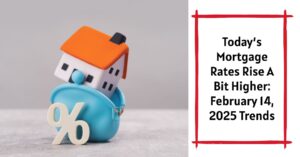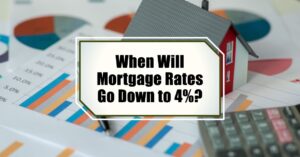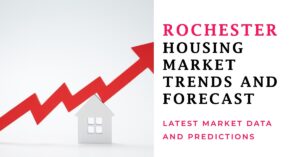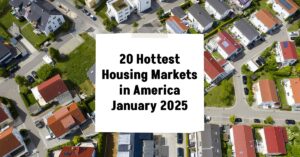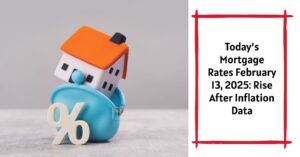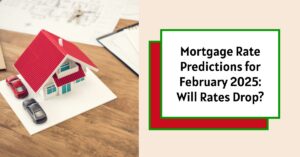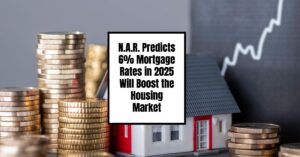As of February 14, 2025, mortgage rates have slightly increased. The average rate for a 30-year fixed-rate mortgage is now 6.92%, a small uptick of 0.01% from the previous week. This slight increase in rates is just one aspect of a complex and evolving housing market. Understanding the factors influencing these rates can empower homebuyers and help them make informed decisions. The current economic conditions, coupled with the policies enacted by the Federal Reserve (Fed), play a significant role in shaping these lending rates.
Today’s Mortgage Rates February 14, 2025: Rates Rise A Bit Higher
Key Takeaways
- Current Average Rates: 30-year fixed at 6.92%, 15-year fixed at 6.21%.
- Recent Changes: Slight increases of 0.01% and 0.03% for 30-year and 15-year fixed rates, respectively.
- Market Outlook: Experts predict rates will hover between 6% and 7% for 2025.
- Inflation Concerns: Recent inflation data continues to impact borrowing costs.
- Best Actions: Homebuyers should compare multiple mortgage options to secure the best rates.
Current Average Mortgage Rates
As of February 14, 2025, the following mortgage rates are in effect:
| Loan Type | Current Rate (%) | Change from Last Week (%) |
|---|---|---|
| 30-Year Fixed-Rate Mortgage | 6.92% | +0.01% |
| 15-Year Fixed-Rate Mortgage | 6.21% | +0.03% |
| 30-Year Fixed-Rate Jumbo | 7.03% | +0.02% |
| 5/1 Adjustable-Rate Mortgage | 6.30% | -0.02% |
| 10-Year Fixed-Rate Mortgage | 6.07% | +0.11% |
(Source: Bankrate)
Are Mortgage Rates Considered High Right Now?
Mortgage rates have seen a significant rise since their record lows during the pandemic, when rates dipped below 3%. While rates currently hover around the 7% mark, many potential buyers might feel discouraged, leading to the perception that the market is unapproachable. However, it's essential to place these rates within the context of historical averages. For instance, over the long term, a 6.92% rate might be relatively high compared to the near-zero rate environment experienced during the pandemic but lower compared to historical data from before 2020 when rates were often above 7%.
Many economic factors influence these mortgage rates, including:
- Federal Reserve Policies: The Fed’s actions in controlling inflation have a direct impact on mortgage rates. For instance, the series of interest rate hikes starting in 2022 has played a vital role in pushing these rates higher.
- Economic Conditions: Reports of job growth and GDP can influence the bond market, subsequently affecting mortgage rates. A strong economy normally leads to higher mortgage rates due to increased demand for credit.
- Market Sentiment: Expectations around inflation and fiscal policies can prompt speculation in the bond market, creating shifts in mortgage costs.
Mortgage Interest Rate Projections
Looking ahead, experts have projected that the averages for 30-year fixed-rate mortgages will stabilize between 6% and 7% over the course of 2025. A recent forecast also suggests rates may drop to an average of 6.4% by the end of the year if economic indicators start signaling a possible recession. However, this will be contingent on various factors:
- Inflation Trends: If inflation remains persistent, the Fed may need to keep interest rates high, directly translating to elevated mortgage rates.
- Housing Supply and Demand: If inventory levels in the housing market increase and competition decreases, it could create a more favorable situation for buyers, potentially leading to stable mortgage rates.
- Federal Reserve Meeting: The Fed's next policy meeting in May or June could also pivot the direction of mortgage rates, depending on their approach to managing inflationary pressures.
What is a Good Mortgage Type and Term?
When considering a mortgage, understanding the different loan types and terms is crucial. The most common options available to prospective buyers are:
- 30-Year Fixed-Rate Mortgages: This type of loan is popular due to its stability. Borrowers appreciate the fixed interest rate for the duration of the loan. While this often means a higher total payment over time compared to shorter-term loans, it results in more manageable monthly payments.
- 15-Year Fixed-Rate Mortgages: With a shorter term, these mortgages are appealing for those who can afford higher payments right away but want to reduce the overall interest paid and eliminate their mortgage quicker.
- Adjustable-Rate Mortgages (ARMs): Particularly the 5/1 ARM, offers a lower introductory rate for the first five years, after which the rate adjusts annually based on market conditions. This option may benefit those planning on relocating within a short time.
Choosing the right mortgage depends on personal circumstances and financial goals. It's crucial for borrowers to carefully assess their current financial liabilities, potential for income growth, and how long they plan to stay in a particular home.
Recommended Read:
Mortgage Rates Trends as of February 13, 2025
Mortgage Rate Predictions for February 2025: Will Rates Drop?
Mortgage Interest Rates Forecast for Next 10 Years
Interest Rate Forecast for Next 10 Years: 2025-2035
Mortgage Rates Expected to Rise Further Due to Strong Jobs Data
Calculate Your Monthly Mortgage Payment
Understanding your monthly payment is crucial for effective budget management and financial planning regarding homeownership. Here are a few example monthly payments based on different mortgage amounts at the current rate of 6.92% for a 30-year fixed mortgage:
Monthly Payment on $150,000 Mortgage
For a $150,000 mortgage at 6.92%, the monthly payment would be approximately $990.43.
Monthly Payment on $200,000 Mortgage
With the same mortgage type, the payment for a $200,000 mortgage would yield about $1,320.57.
Monthly Payment on $300,000 Mortgage
For a $300,000 mortgage, the monthly cost would be around $1,980.86.
Monthly Payment on $400,000 Mortgage
A loan of $400,000 would result in a monthly payment of roughly $2,641.15.
Monthly Payment on $500,000 Mortgage
Finally, a $500,000 mortgage translates to a monthly payment of approximately $3,301.43.
It's important to note that these figures only reflect principal and interest, excluding property taxes, insurance, and any potential homeowners association (HOA) fees, which can significantly impact your total monthly payment.
How Can I Get the Lowest Mortgage Rates?
Navigating the mortgage landscape to find the most competitive rates requires diligence and strategy. Here are essential steps to take:
- Save for a Larger Down Payment: While a total of 20% has long been the gold standard, any increase in your initial payment reduces the mortgage and thus your interest burden. A larger down payment can also eliminate private mortgage insurance (PMI), which further reduces monthly costs.
- Boost Your Credit Score: A higher credit score leads to favorable rates. Aim to elevate your score above 740 to access the best offers from lenders. Regularly reviewing your credit report and correcting inaccuracies can be beneficial.
- Pay Off Debts: Keeping your debt-to-income ratio at 36% or less can approach optimum affordability for lenders. Paying down existing debts improves your financial profile in the eyes of potential lenders.
- Research Government Programs: For first-time homebuyers, seek out government-sponsored loans like FHA, VA, or USDA loans, which usually have more flexible requirements and can provide lower rates.
- Shop Around for Lenders: The importance of comparison shopping can't be overstated. Make it a priority to review multiple offers from different lenders and seek clarity on points, terms, and fees to find the best loans available.
- Consider Locking in Rates: If you fear that rates will rise unexpectedly, consider locking in during the application process. This ensures you get the quoted rate even if rates increase before your loan closes.
- Stay Informed About Economic Trends: Keeping abreast of financial news related to the Fed's decisions, inflation, and housing market trends will help you anticipate changes that could affect mortgage rates.
The Broader Housing Market Context
The current state of mortgage rates cannot be viewed in isolation; it is tied intricately to the overall health of the housing market. The combination of high rates and rising home prices has left many would-be buyers on the sidelines. Despite these challenges, there are signs of resilience in the market. Some buyers are still eager to enter, motivated by personal circumstances rather than economic conditions.
For homebuilders, high rates have posed challenges, leading to a decrease in new construction growth. However, increasing inventory in some areas may provide opportunities for buyers, particularly if prices begin to moderate.
In contrast, renters may find it increasingly difficult to transition into homeownership as rental rates continue to climb. This dynamic underscores the need for strategies to boost housing availability and affordability that involve collaboration between the public sector and private industry.
In summary, mortgage rates as of February 14, 2025, have experienced a slight increase and are projected to remain in a range between 6% and 7% for the near future. Interest rates are dictated by multifaceted economic factors, highlighting the importance of strategic planning for prospective homebuyers. Understanding these rates, the type of mortgage best suited to your situation, and the intricacies of the broader housing market will allow you to navigate the landscape successfully.
Work with Norada in 2025, Your Trusted Source for
Real Estate Investing
With mortgage rates fluctuating, investing in turnkey real estate
can help you secure consistent returns.
Expand your portfolio confidently, even in a shifting interest rate environment.
Speak with our expert investment counselors (No Obligation):
(800) 611-3060
Recommended Read:
- Mortgage Rates Forecast for the Next 3 Years: 2025 to 2027
- 30-Year Mortgage Rate Forecast for the Next 5 Years
- 15-Year Mortgage Rate Forecast for the Next 5 Years
- Why Are Mortgage Rates Going Up in 2025: Will Rates Drop?
- Why Are Mortgage Rates So High and Predictions for 2025
- NAR Predicts 6% Mortgage Rates in 2025 Will Boost Housing Market
- Mortgage Rates Predictions for 2025: Expert Forecast
- Will Mortgage Rates Ever Be 3% Again: Future Outlook
- Mortgage Rates Predictions for Next 2 Years
- Mortgage Rate Predictions for Next 5 Years
- Mortgage Rate Predictions for 2025: Expert Forecast
- Mortgage Rate Predictions: Why 2% and 3% Rates are Out of Reach
- How Lower Mortgage Rates Can Save You Thousands?
- How to Get a Low Mortgage Interest Rate?
- Will Mortgage Rates Ever Be 4% Again?
